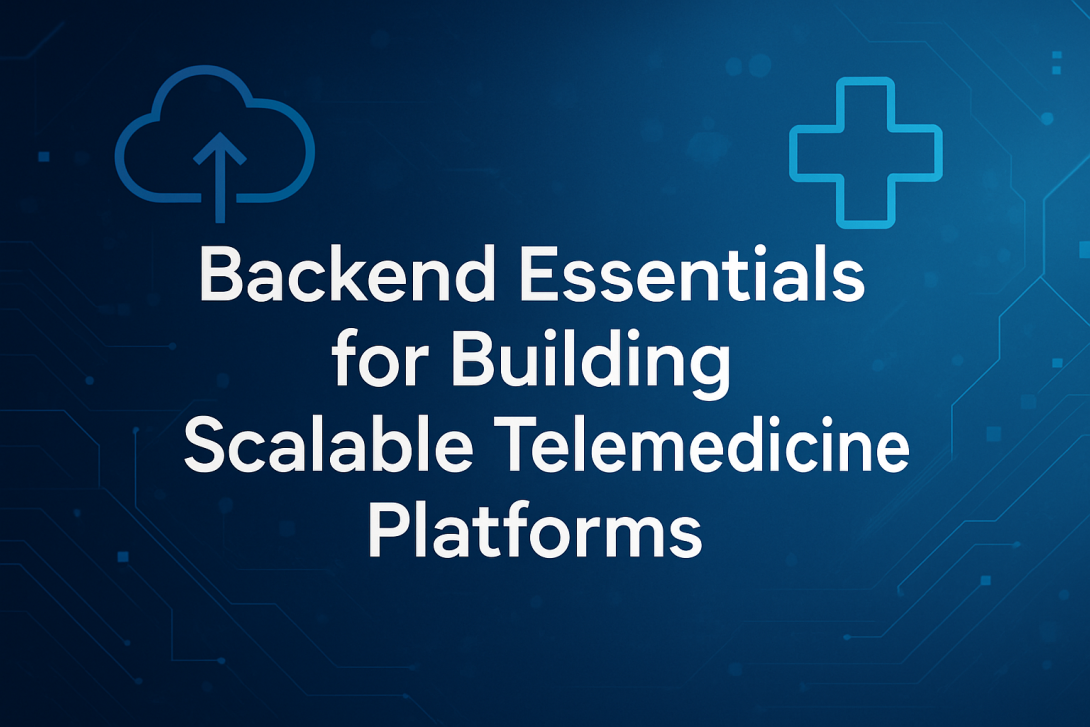
In today’s digital healthcare ecosystem, telemedicine platforms play a significant role in making medical services more accessible. These platforms depend on a robust backend infrastructure to ensure reliability, security, and scalability. A weak backend can result in data bottlenecks, security risks, and an overall poor user experience. This blog explores the essential backend components required to build scalable telemedicine platforms and highlights best practices for long-term sustainability.
Understanding the Role of Backend in Telemedicine
The backend serves as the foundation of a telemedicine platform. It handles everything from storing sensitive patient data to managing real-time video consultations. The backend must also ensure seamless integration between different modules like appointment scheduling, billing, and prescription management.
A well-structured backend not only supports smooth operations but also scales with user demand. For example, during a pandemic or health emergency, the platform should accommodate a sudden surge in traffic without crashing.
Key Backend Components for Telemedicine Platforms
1. Cloud Infrastructure
Cloud computing provides the flexibility and scalability needed in telemedicine. Public cloud providers like AWS, Google Cloud, and Microsoft Azure offer tools to handle dynamic workloads and store large volumes of data securely. Cloud solutions also facilitate disaster recovery and ensure high availability.
Cloud-native services allow telemedicine platforms to scale horizontally by adding new servers or resources based on usage. This flexibility makes cloud an ideal choice for building modern healthcare applications.
2. Database Management Systems
Efficient databases are critical to managing patient records, treatment histories, prescriptions, and billing data.
- Relational Databases: SQL-based databases like PostgreSQL are used for structured data.
- NoSQL Databases: MongoDB and Cassandra handle unstructured or semi-structured data like medical imaging.
An optimized database schema and proper indexing enhance performance and reduce query response time.
3. API Integration
Application Programming Interfaces (APIs) allow different components and third-party services to interact. In telemedicine, APIs connect the platform with:
- Electronic Health Records (EHRs)
- Insurance verification services
- Pharmacy databases
- Payment gateways
Well-documented and secure APIs are necessary to maintain data flow across modules without latency.
4. Security Measures
Security is paramount in healthcare. Telemedicine platforms must implement strong security protocols such as:
- End-to-end data encryption
- Role-based access control (RBAC)
- Two-factor authentication (2FA)
The platform must comply with standards like HIPAA in the U.S. and GDPR in Europe. Routine audits and vulnerability assessments help mitigate data breaches.
5. Load Balancing and Performance Optimization
Load balancers distribute traffic across multiple servers, ensuring no single server is overwhelmed. This prevents downtime and enhances the responsiveness of the application.
Other optimization strategies include:
- Content Delivery Networks (CDNs)
- Data caching with Redis or Memcached
- Asynchronous processing for non-critical tasks
These measures help maintain a smooth experience even during peak usage times.
Scalability Techniques
1. Microservices Architecture
A microservices-based backend divides the platform into smaller, independently deployable modules. For example, one service can handle appointments while another handles billing. This separation allows for:
- Easier maintenance
- Independent scaling
- Faster development cycles
This architectural style aligns with modern Backend Development practices.
2. Event-Driven Systems
In event-driven architecture, services communicate through events, which makes the system more responsive and loosely coupled. Tools like Apache Kafka or RabbitMQ can handle real-time event streams efficiently.
Event-driven systems are ideal for use cases such as:
- Instant notifications
- Real-time chat between doctors and patients
- Live monitoring from IoT devices
3. Containerisation and Orchestration
Tools like Docker and Kubernetes simplify deployment and scaling. Containerization packages applications with all their dependencies, ensuring consistent environments across development and production.
Kubernetes, in particular, automates:
- Load distribution
- Service discovery
- Fault tolerance
This results in lower operational overhead and better scalability.
Trends Shaping Backend Development in Telemedicine
1. Artificial Intelligence and Machine Learning
AI and ML algorithms enhance decision-making by analyzing patient data, predicting outcomes, and automating administrative tasks. The backend must be capable of handling large datasets and running model inference efficiently.
Examples include:
- AI chatbots for patient triage
- ML-based diagnostic tools
These features are becoming common in healthcare software trends.
2. Blockchain Integration
Blockchain ensures secure, transparent, and immutable medical records. It provides:
- Decentralized identity verification
- Tamper-proof audit logs
Platforms like Hyperledger Fabric and Ethereum are being tested for healthcare applications.
3. IoT in Healthcare
IoT devices such as wearable monitors and remote diagnostic tools send continuous data to the backend. The system must process and store this real-time data effectively.
This trend is a critical component of modern telemedicine software development.
Best Practices for a Scalable Telemedicine Backend
1. Compliance and Governance
Ensure the platform complies with healthcare regulations. Use audit logs and access controls to support transparency.
2. Continuous Monitoring
Monitoring tools like Prometheus, Grafana, and ELK Stack offer insights into performance and errors. Set up alerts for:
- CPU and memory usage
- API latency
- Failed login attempts
3. Automated Testing and CI/CD Pipelines
Automated testing ensures code reliability. Continuous Integration/Continuous Deployment (CI/CD) pipelines speed up deployment and reduce human error.
These pipelines should include:
- Unit and integration tests
- Linting and static code analysis
- Blue/green deployment strategy
4. Documentation and Logs
Maintain thorough documentation for APIs, services, and workflows. Logging helps trace issues during incidents and supports debugging.
Conclusion
A scalable telemedicine platform is built on a well-structured and secure backend. Cloud infrastructure, database optimization, and API integration form the core. Trends such as AI, IoT, and blockchain are reshaping backend development in healthcare.
Staying current with backend development trends ensures your platform remains competitive and efficient. Developers and stakeholders must adopt these strategies to meet the growing demand for remote healthcare solutions.
For more detailed technical insights, check out our dedicated resources on Backend Development.
